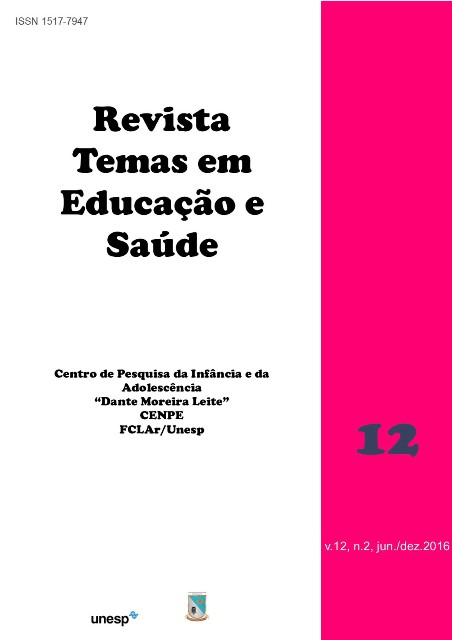THE CULTURE OF PERNAMBUCO AND THE FORMATION OF COMMUNITY THERAPISTS
DOI:
https://doi.org/10.26673/tes.v12i2.10231Keywords:
Public health. Complementary therapies. Cultural anthropology. Folklore. Self esteem.Abstract
The purpose of this study is to explore the history and use of elements of the Pernambuco culture in the formation of community therapists, conducted by the Polo Family Space. The part used as a representation of the relationship between people and their history and traditions, has been constituted as an element of cultural linkage, from the peculiar use of language, Pernambuquês, to the contribution of songs, dances with pluriethnical roots. It also records the history of the implantation of TCI in the State, passing through its recognition, as complementary integrative practice of SUS. The emphasis on issues related to the use of alcohol and other drugs, as well as the various fields of use in health care, teaching and research.Downloads
References
ABRIL Coleções. Receitas das festas populares. São Paulo: Ed. Abril, 2009.
ALEPE - Assembleia Legislativa do Estado de Pernambuco. Todos os ritmos do toadas de Pernambuco. Disponível em: . Acesso em: 25 maio 2015.
BENJAMIM, R. Cultura pernambucana. João Pessoa: Editora Grafset, 2011.
BUENO, D. Cordel do pernambuquês, (s.n.t.).
BRASIL. Instituto Brasileiro de Geografia e Estatística. CENSO 2010. Disponível em: <http://www.censo2010.ibge.gov.br> Acesso em: 18 mai. 2015.
CARRERO, R. Oficina de criação literária. Disponível em: . Acesso em: 28 abr. 2015.
CIS – Centro Integrado de Saúde. Saúde holística e alternativa. Disponível em: <https://www.facebook.com/pages/CIS-Centro-Integrado-de-Sa%C3%BAde/473420549360187?fref=ts>. Acesso em: 24 maio 2015.
DIÁRIO DE PERNAMBUCO. O que foi o Movimento Manguebeat? Disponível em: <http://www.diariodepernambuco.com.br/app/noticia/diarinho/2014/02/21/interna_diarinho,490736/o-que-foi-o-movimento-manguebeat.shtml>. Acesso em: 26 mai. 2015.
DIÁRIO DE PERNAMBUCO. Ariano Suassuna. Disponível em: <http://www.diariodepernambuco.com.br/especiais/viver/ariano-suassuna/#sthash.HW1yv3nu.dpuf>. Acesso em: 20 mai. 2015.
FERREIRA NETO, C. Indígenas e negros no Vale do Jaguaribe: entre o cativeiro e a liberdade. Disponível em: <http://www.apeoc.org.br/extra/artigos_cientificos/Indigenas_e_Negros_no_Vale_Jaguaribe.pdf>. Acesso em: 30 jan. 2017
FILHO, C. F (Org.). Espetáculos populares de Pernambuco. Recife: Bargaço, 1999.
GASPAR, L. Ciranda e Danças indígenas do Brasil. Pesquisa Escolar Online, Fundação Joaquim Nabuco, Recife. Disponível em: <http://basilio.fundaj.gov.br/pesquisaescolar/>. Acesso em: 21 mai. 2015.
GONZAGA, L. A feira de Caruaru. Disponível em: <http://letras.mus.br/luiz-gonzaga/204732>. Acesso em: 20 mai. 2015.
HOLANDA, S. B. Raízes do Brasil- Coleção Documentos Brasileiros n. 1. 6ª. ed. Rio de Janeiro: Ed. José Olympio; 1971.
LENINE. Leão do Norte. Disponível em: <http://letras.mus.br/lenine/88967/>. Acesso em: 20 mai. 2015.
LIMA, C.; GUEDES, S. O reino mágico da xilo (gravura). Disponível em: <http://www.unicap.br/armorial/35anos/trabalhos/o-reino_xilogravura.pdf>. Acesso em: 20 mai. 2015.
MAIOR, M.S. A língua na boca do povo. Recife: FUNDAJ, Ed. Massangana, 1992.
MAXWELL, V. R. A. C. Introdução: Ariano Suassuna e o movimento armorial. Disponível em <http://www.maxwell.vrac.puc-rio.br/9879/9879_2.PDF>. Acesso em: 20 abr. 2015.
MELLO, L. G. Antropologia cultural: iniciação, teoria e temas. 18ª ed. Petrópolis, Ed. Vozes, 2011.
PERNAMBUCO, Governo do Estado de. História de Pernambuco. Disponível em: <http://www.pe.gov.br>. Acesso em: 18 maio 2015.
PERNAMBUCO. Portal da Cultura de Pernambuco. Disponível em: <https://www.cultura.pe.gov.br/pagina/patrimonio-cultural/>. Acesso em: 05 abri. 2015.
PERNAMBUCO. SECTEC - Secretaria de Ciência, Tecnologia e Inovação. Disponível em: <http://www.lai.pe.gov.br/web/sectec>. Acesso em: 05 abr. 2015.
PORTAL DA FAMÍLIA. Dinâmicas de grupo - 2. Disponível em: <http://www.portaldafamilia.org/sclazer/jogos/dinamicas-em-grupo-2.shtml>. Acesso em: 28 abr. 2015.
PROGRAMA QUE HISTÓRIA É ESSA. Maluguinho. Negro/Índio Guerreiro de Pernambuco. Postada em 26 de fevereiro de 2012. Disponível em: <http://programaquehistoriaeessa.com.br/?p=163>. Acesso em 30 jan. 2017.
SANTOS, A. P. Dança circular. Disponível em: <https://dancacircularufabc.wordpress.com/o-que-sao-dancas-circulares/>. Acesso em 09 maio 2015.
TILDES, F.; PINTO, J. B. A.; MENDES P. Dicionário pernambuquês. Disponível em: <http://www.aisa.com.br/diciope.html>. Acesso em: 18 maio 2015.
TRIBUNA DO NORTE. A história não contada dos índios e negros da terra. Postado em 25 de julho de 2011 - 10h11. Disponível em: <http://www.vermelho.org.br/noticia/159565-1>. Acesso em: 30 jan. 2017.
RECIFE. Porto das letras. Disponível em: <http://www.recife.pe.gov.br/portodasletras/paginas/php/linhadotempo_poesia.php>. Acesso em: 20 maio 2015.
VALENTE, V. Pastoril. Disponível em: <http://basilio.fundaj.gov.br/pesquisaescolar/index.php?option=com_content&view=article&id=608:pastoril&catid=50:letra-p&Itemid=1>. Acesso em: 20 maio 2015
VICTOR, A.; MELLO, F. P.; FINIZOLA, J. Missa do vaqueiro: 40 anos. Recife, Publikimagem, 2012.
Downloads
Published
How to Cite
Issue
Section
License
Os manuscritos aceitos e publicados são de propriedade da Temas em Educação e Saúde. Os artigos publicados e as referências citadas na Temas em Educação e Saúde são de inteira responsabilidade de seus autores. É vedada a tradução para outro idioma sem a autorização escrita do Editor ouvida a Comissão Editorial.







